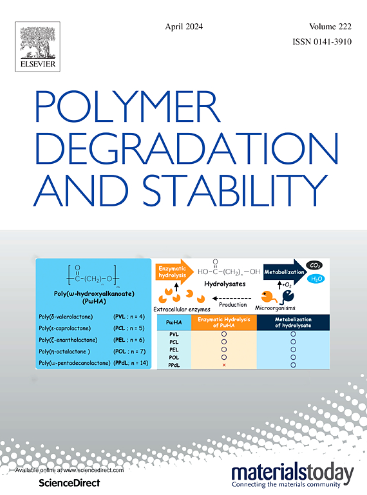通过氧化和分子量还原测定预处理低密度聚乙烯(LDPE)的生物降解
IF 6.3
2区 化学
Q1 POLYMER SCIENCE
引用次数: 0
摘要
每年产生数百万公吨的塑料垃圾,其中极少部分被回收利用。因此,迫切需要找到有效和可持续的塑料降解方法,特别是聚乙烯,全球生产最多的聚合物。在这里,我们模拟了甲虫记录的策略,其特征是物理,化学和微生物处理的结合,以生物降解低密度聚乙烯(LDPE)。重要的是,我们通过多种技术表征了LDPE的降解,包括失重分析、FTIR、GPC、GC-MS和SEM,这使我们能够确定提高LDPE生物降解的最佳处理组合。与一些预期相反,我们发现超声波不会导致LDPE降解,反而可以防止其破碎。然而,我们通过简单地将LDPE暴露在环境友好的阴离子表面活性剂中,成功地将羰基引入聚合物主链。这种预处理有效地将LDPE切割了约9%,将其分解成更短的碳链,便于微生物进行后续的生物降解。从燃料箱中分离出来的酵母解脂耶氏菌能够在正石蜡中生长,它不仅在短碳链降解试验中优于其他微生物,而且还能附着在LDPE表面,在那里它以LDPE作为唯一的碳源生存和生长。因此,我们的研究结果为进一步开发塑料垃圾的潜在解决方案铺平了道路,呼吁跨学科研究和创新解决方案来应对全球环境挑战。本文章由计算机程序翻译,如有差异,请以英文原文为准。

Biodegradation of pre-treated low-density polyethylene (LDPE) by Yarrowia lipolytica determined by oxidation and molecular weight reduction
Millions of metric tonnes of plastic waste are generated every year, with a minimal portion being recycled. Therefore, there is an urgent need to find effective and sustainable methods for plastic degradation, especially polyethylene, the most manufactured polymer globally. Here, we emulate the strategies documented for beetles, characterized by a combination of physical, chemical, and microbiological treatments, to biodegrade low-density polyethylene (LDPE). Importantly, we characterize LDPE degradation through multiple techniques, including weight loss analysis, FTIR, GPC, GC–MS, and SEM, which allowed us to identify the optimal combination of treatments to enhance LDPE biodegradation. Contrary to some expectations, we find that ultrasonication does not contribute to LDPE degradation but may instead protect against its fragmentation. However, we successfully introduce carbonyl groups into the polymer backbone, by simply exposing LDPE to environmentally friendly anionic surfactant. This pretreatment effectively cleaves LDPE by approximately 9%, breaking it into shorter carbon chains that are more accessible to microbes for subsequent biodegradation. The yeast Yarrowia lipolytica, isolated from fuel tanks and able to grow in n-paraffines, not only outperforms other microbes in assays of short carbon chain degradation, but also attaches to the LDPE surface, where it survives and grows using LDPE as sole carbon source. Our findings, therefore, pave the way for further developing a potential solution to plastic waste, calling for interdisciplinary research and innovative solutions in tackling global environmental challenges.
求助全文
通过发布文献求助,成功后即可免费获取论文全文。
去求助
来源期刊

Polymer Degradation and Stability
化学-高分子科学
CiteScore
10.10
自引率
10.20%
发文量
325
审稿时长
23 days
期刊介绍:
Polymer Degradation and Stability deals with the degradation reactions and their control which are a major preoccupation of practitioners of the many and diverse aspects of modern polymer technology.
Deteriorative reactions occur during processing, when polymers are subjected to heat, oxygen and mechanical stress, and during the useful life of the materials when oxygen and sunlight are the most important degradative agencies. In more specialised applications, degradation may be induced by high energy radiation, ozone, atmospheric pollutants, mechanical stress, biological action, hydrolysis and many other influences. The mechanisms of these reactions and stabilisation processes must be understood if the technology and application of polymers are to continue to advance. The reporting of investigations of this kind is therefore a major function of this journal.
However there are also new developments in polymer technology in which degradation processes find positive applications. For example, photodegradable plastics are now available, the recycling of polymeric products will become increasingly important, degradation and combustion studies are involved in the definition of the fire hazards which are associated with polymeric materials and the microelectronics industry is vitally dependent upon polymer degradation in the manufacture of its circuitry. Polymer properties may also be improved by processes like curing and grafting, the chemistry of which can be closely related to that which causes physical deterioration in other circumstances.
 求助内容:
求助内容: 应助结果提醒方式:
应助结果提醒方式:


